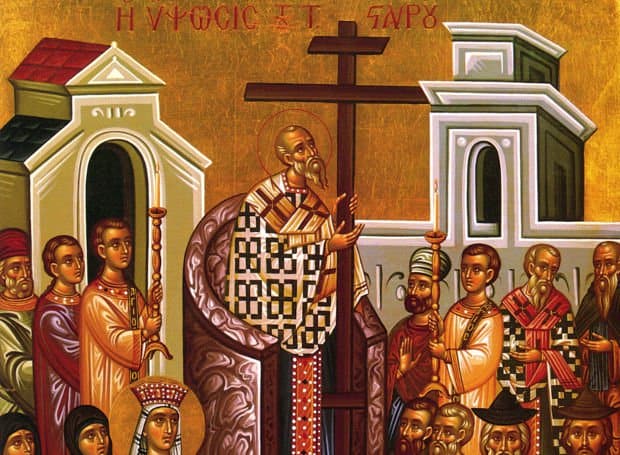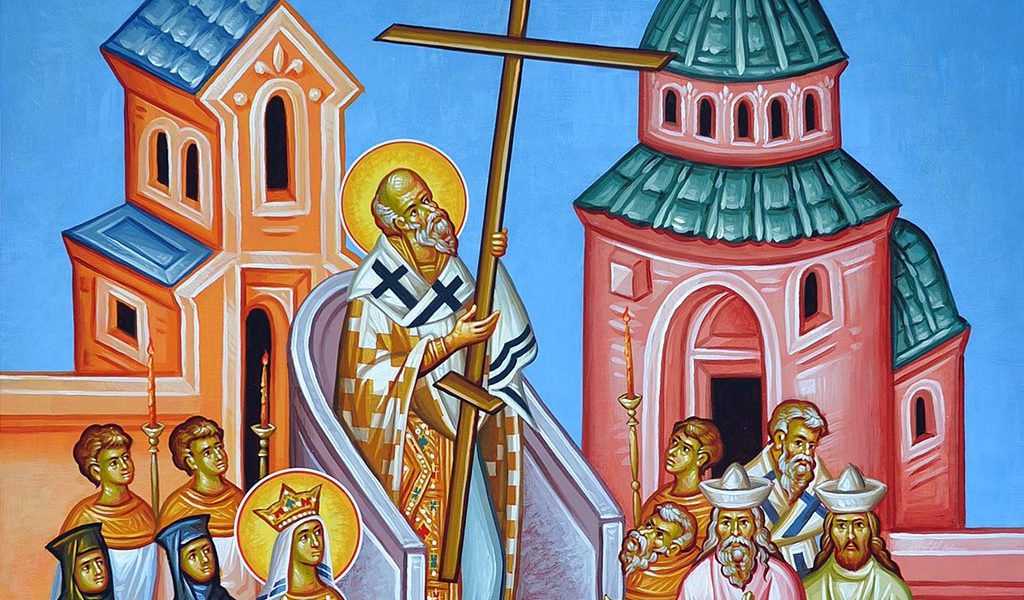
The Feast of the Universal Exaltation of the Precious and Life-Giving Cross is a blessed day and celebration of the tremendous power of the Cross of our Lord and is celebrated each year on September 14. Through the Cross, the power and wisdom of God have been revealed. By the Cross, we are reconciled to Christ, and we can find true and enduring peace. It is the Cross that directs us to Christ and to the way of salvation and eternal life.
The Feast commemorates the finding of the True Cross of our Lord and Savior Jesus Christ by Saint Helen, the mother of the Emperor Constantine.
In the twentieth year of his reign (326), Emperor Constantine sent his mother Saint Helen to Jerusalem to venerate the holy places and to find the site of the Holy Sepulchre and of the Cross. Relying upon the oral tradition of the faithful, Saint Helen found the precious Cross together with the crosses of the two thieves crucified with our Lord. However, Helen had no way of determining which was the Cross of Christ.
With the healing of a dying woman who touched one of the crosses, Patriarch Macarius of Jerusalem identified the True Cross of Christ. Saint Helen and her court venerated the Precious and Life-Giving Cross along with many others who came to see this great instrument of Redemption.
![]()
The Patriarch mounted the ambo (pulpit) and lifted the Cross with both hands so that all of the people gathered could see it. The crowd responded with "Lord have mercy".
This became the occasion of the institution in all of the Churches of the Exaltation of the Precious Cross, not only in memory of the event of the finding of the Cross but also to celebrate how an instrument of shame was used to overcome death and bring salvation and eternal life.
The Feast is an opportunity outside of the observances of Holy Week to celebrate the full significance of the victory of the Cross over the powers of the world, and the triumph of the wisdom of God through the Cross over the wisdom of this world. This Feast also gives the Church an opportunity to relish the full glory of the Cross as a source of light, hope, and victory for Christ's people. It is also a time to celebrate the universality of the work of redemption accomplished through the Cross: the entire universe is seen through the light of the Cross, the new Tree of Life which provides nourishment for those who have been redeemed in Christ.
On the day of the Feast at the conclusion of the Matins or of the Divine Liturgy, a special service is held. The Cross is placed on a tray surrounded by branches of basil and is taken in solemn procession through the church to the chanting of the Hymn of the Feast. The tray is placed on a table, and the priest takes the Cross and offers petitions from each side of the table, the four directions of the compass. This represents the universal nature of the offering of Christ upon the Cross. As the people respond by chanting "Lord have mercy", the priest raises and lowers the cross, a commemoration of its finding and exaltation. At the conclusion of the service, the people come and venerate the cross and receive the basil from the priest. The basil is used and offered, as it was the fragrant flower growing where the Cross was found.
Today as we venerate the Holy Cross of our Lord, and Orthodox Christians around the world raise the symbol of the sacred and precious wood, we proclaim the Cross to be an invincible shield, a divine scepter, and the boast of the faithful. We exalt it by affirming that the Cross sanctifies to the ends of the world. We hail the life-giving Cross as the “unconquerable trophy of godliness, door to Paradise, and succor of the faithful.” Through the Cross our enemies are vanquished, freedom from corruption and mortality is established, and salvation is offered universally.
As the Cross is lifted up, we marvel at how an instrument meant for torture and shame leads us to abundant and eternal life. We contemplate how an object that inflicted suffering and death reveals the glory and power of God. We offer praise and thanksgiving, for instead of hate and inhumanity, the Cross has become love and freedom. Instead of suffering, we find healing and hope. The Cross leads us from death and life, and through the Cross, we know that all things are possible to those who believe in Christ.
*Source: GOACH

